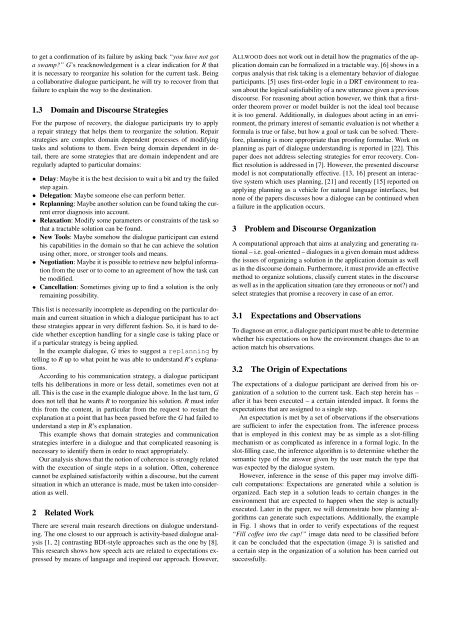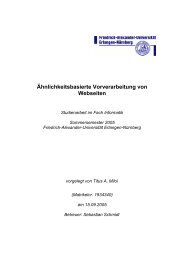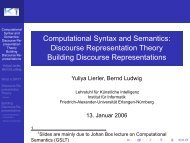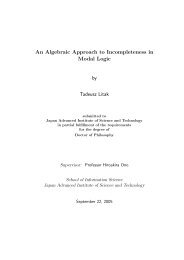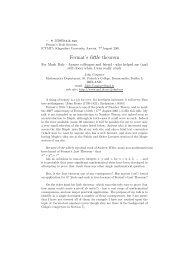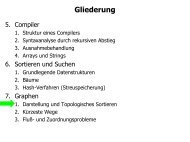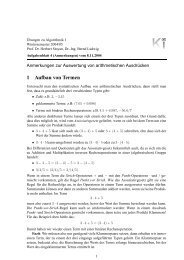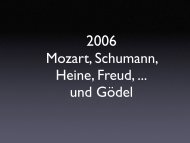Pragmatics First: Coherence in Dialogue follows Acting in the ...
Pragmatics First: Coherence in Dialogue follows Acting in the ...
Pragmatics First: Coherence in Dialogue follows Acting in the ...
Create successful ePaper yourself
Turn your PDF publications into a flip-book with our unique Google optimized e-Paper software.
to get a confirmation of its failure by ask<strong>in</strong>g back “you have not gota swamp?” G’s reacknowledgement is a clear <strong>in</strong>dication for R thatit is necessary to reorganize his solution for <strong>the</strong> current task. Be<strong>in</strong>ga collaborative dialogue participant, he will try to recover from thatfailure to expla<strong>in</strong> <strong>the</strong> way to <strong>the</strong> dest<strong>in</strong>ation.1.3 Doma<strong>in</strong> and Discourse StrategiesFor <strong>the</strong> purpose of recovery, <strong>the</strong> dialogue participants try to applya repair strategy that helps <strong>the</strong>m to reorganize <strong>the</strong> solution. Repairstrategies are complex doma<strong>in</strong> dependent processes of modify<strong>in</strong>gtasks and solutions to <strong>the</strong>m. Even be<strong>in</strong>g doma<strong>in</strong> dependent <strong>in</strong> detail,<strong>the</strong>re are some strategies that are doma<strong>in</strong> <strong>in</strong>dependent and areregularly adapted to particular doma<strong>in</strong>s:• Delay: Maybe it is <strong>the</strong> best decision to wait a bit and try <strong>the</strong> failedstep aga<strong>in</strong>.• Delegation: Maybe someone else can perform better.• Replann<strong>in</strong>g: Maybe ano<strong>the</strong>r solution can be found tak<strong>in</strong>g <strong>the</strong> currenterror diagnosis <strong>in</strong>to account.• Relaxation: Modify some parameters or constra<strong>in</strong>ts of <strong>the</strong> task sothat a tractable solution can be found.• New Tools: Maybe somehow <strong>the</strong> dialogue participant can extendhis capabilities <strong>in</strong> <strong>the</strong> doma<strong>in</strong> so that he can achieve <strong>the</strong> solutionus<strong>in</strong>g o<strong>the</strong>r, more, or stronger tools and means.• Negotiation: Maybe it is possible to retrieve new helpful <strong>in</strong>formationfrom <strong>the</strong> user or to come to an agreement of how <strong>the</strong> task canbe modified.• Cancellation: Sometimes giv<strong>in</strong>g up to f<strong>in</strong>d a solution is <strong>the</strong> onlyrema<strong>in</strong><strong>in</strong>g possibility.This list is necessarily <strong>in</strong>complete as depend<strong>in</strong>g on <strong>the</strong> particular doma<strong>in</strong>and current situation <strong>in</strong> which a dialogue participant has to act<strong>the</strong>se strategies appear <strong>in</strong> very different fashion. So, it is hard to decidewhe<strong>the</strong>r exception handl<strong>in</strong>g for a s<strong>in</strong>gle case is tak<strong>in</strong>g place orif a particular strategy is be<strong>in</strong>g applied.In <strong>the</strong> example dialogue, G tries to suggest a replann<strong>in</strong>g bytell<strong>in</strong>g to R up to what po<strong>in</strong>t he was able to understand R’s explanations.Accord<strong>in</strong>g to his communication strategy, a dialogue participanttells his deliberations <strong>in</strong> more or less detail, sometimes even not atall. This is <strong>the</strong> case <strong>in</strong> <strong>the</strong> example dialogue above. In <strong>the</strong> last turn, Gdoes not tell that he wants R to reorganize his solution. R must <strong>in</strong>ferthis from <strong>the</strong> content, <strong>in</strong> particular from <strong>the</strong> request to restart <strong>the</strong>explanation at a po<strong>in</strong>t that has been passed before <strong>the</strong> G had failed tounderstand a step <strong>in</strong> R’s explanation.This example shows that doma<strong>in</strong> strategies and communicationstrategies <strong>in</strong>terfere <strong>in</strong> a dialogue and that complicated reason<strong>in</strong>g isnecessary to identify <strong>the</strong>m <strong>in</strong> order to react appropriately.Our analysis shows that <strong>the</strong> notion of coherence is strongly relatedwith <strong>the</strong> execution of s<strong>in</strong>gle steps <strong>in</strong> a solution. Often, coherencecannot be expla<strong>in</strong>ed satisfactorily with<strong>in</strong> a discourse, but <strong>the</strong> currentsituation <strong>in</strong> which an utterance is made, must be taken <strong>in</strong>to considerationas well.2 Related WorkThere are several ma<strong>in</strong> research directions on dialogue understand<strong>in</strong>g.The one closest to our approach is activity-based dialogue analysis[1, 2] contrast<strong>in</strong>g BDI-style approaches such as <strong>the</strong> one by [8].This research shows how speech acts are related to expectations expressedby means of language and <strong>in</strong>spired our approach. However,ALLWOOD does not work out <strong>in</strong> detail how <strong>the</strong> pragmatics of <strong>the</strong> applicationdoma<strong>in</strong> can be formalized <strong>in</strong> a tractable way. [6] shows <strong>in</strong> acorpus analysis that risk tak<strong>in</strong>g is a elementary behavior of dialogueparticipants. [5] uses first-order logic <strong>in</strong> a DRT environment to reasonabout <strong>the</strong> logical satisfiability of a new utterance given a previousdiscourse. For reason<strong>in</strong>g about action however, we th<strong>in</strong>k that a firstorder<strong>the</strong>orem prover or model builder is not <strong>the</strong> ideal tool becauseit is too general. Additionally, <strong>in</strong> dialogues about act<strong>in</strong>g <strong>in</strong> an environment,<strong>the</strong> primary <strong>in</strong>terest of semantic evaluation is not whe<strong>the</strong>r aformula is true or false, but how a goal or task can be solved. Therefore,plann<strong>in</strong>g is more appropriate than proof<strong>in</strong>g formulae. Work onplann<strong>in</strong>g as part of dialogue understand<strong>in</strong>g is reported <strong>in</strong> [22]. Thispaper does not address select<strong>in</strong>g strategies for error recovery. Conflictresolution is addressed <strong>in</strong> [7]. However, <strong>the</strong> presented discoursemodel is not computationally effective. [13, 16] present an <strong>in</strong>teractivesystem which uses plann<strong>in</strong>g, [21] and recently [15] reported onapply<strong>in</strong>g plann<strong>in</strong>g as a vehicle for natural language <strong>in</strong>terfaces, butnone of <strong>the</strong> papers discusses how a dialogue can be cont<strong>in</strong>ued whena failure <strong>in</strong> <strong>the</strong> application occurs.3 Problem and Discourse OrganizationA computational approach that aims at analyz<strong>in</strong>g and generat<strong>in</strong>g rational– i.e. goal-oriented – dialogues <strong>in</strong> a given doma<strong>in</strong> must address<strong>the</strong> issues of organiz<strong>in</strong>g a solution <strong>in</strong> <strong>the</strong> application doma<strong>in</strong> as wellas <strong>in</strong> <strong>the</strong> discourse doma<strong>in</strong>. Fur<strong>the</strong>rmore, it must provide an effectivemethod to organize solutions, classify current states <strong>in</strong> <strong>the</strong> discourseas well as <strong>in</strong> <strong>the</strong> application situation (are <strong>the</strong>y erroneous or not?) andselect strategies that promise a recovery <strong>in</strong> case of an error.3.1 Expectations and ObservationsTo diagnose an error, a dialogue participant must be able to determ<strong>in</strong>ewhe<strong>the</strong>r his expectations on how <strong>the</strong> environment changes due to anaction match his observations.3.2 The Orig<strong>in</strong> of ExpectationsThe expectations of a dialogue participant are derived from his organizationof a solution to <strong>the</strong> current task. Each step here<strong>in</strong> has –after it has been executed – a certa<strong>in</strong> <strong>in</strong>tended impact. It forms <strong>the</strong>expectations that are assigned to a s<strong>in</strong>gle step.An expectation is met by a set of observations if <strong>the</strong> observationsare sufficient to <strong>in</strong>fer <strong>the</strong> expectation from. The <strong>in</strong>ference processthat is employed <strong>in</strong> this context may be as simple as a slot-fill<strong>in</strong>gmechanism or as complicated as <strong>in</strong>ference <strong>in</strong> a formal logic. In <strong>the</strong>slot-fill<strong>in</strong>g case, <strong>the</strong> <strong>in</strong>ference algorithm is to determ<strong>in</strong>e whe<strong>the</strong>r <strong>the</strong>semantic type of <strong>the</strong> answer given by <strong>the</strong> user match <strong>the</strong> type thatwas expected by <strong>the</strong> dialogue system.However, <strong>in</strong>ference <strong>in</strong> <strong>the</strong> sense of this paper may <strong>in</strong>volve difficultcomputations: Expectations are generated while a solution isorganized. Each step <strong>in</strong> a solution leads to certa<strong>in</strong> changes <strong>in</strong> <strong>the</strong>environment that are expected to happen when <strong>the</strong> step is actuallyexecuted. Later <strong>in</strong> <strong>the</strong> paper, we will demonstrate how plann<strong>in</strong>g algorithmscan generate such expectations. Additionally, <strong>the</strong> example<strong>in</strong> Fig. 1 shows that <strong>in</strong> order to verify expectations of <strong>the</strong> request“Fill coffee <strong>in</strong>to <strong>the</strong> cup!” image data need to be classified beforeit can be concluded that <strong>the</strong> expectation (image 3) is satisfied anda certa<strong>in</strong> step <strong>in</strong> <strong>the</strong> organization of a solution has been carried outsuccessfully.


